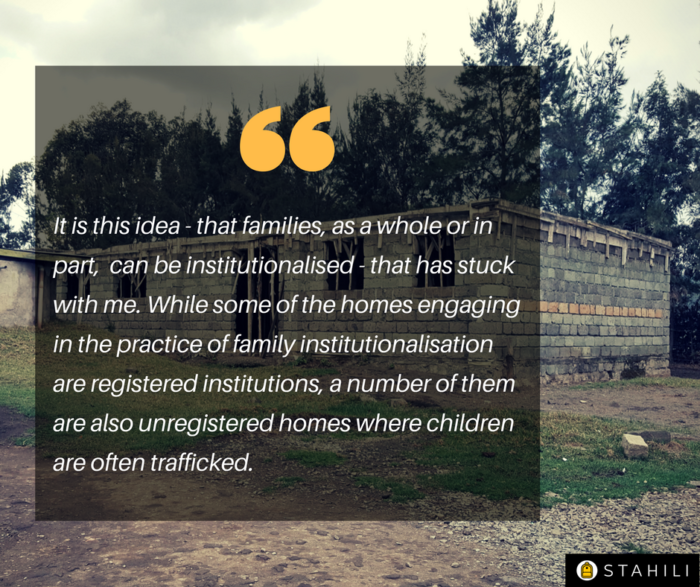Family Institutionalisation

Stahili’s Director and Co-Founder, Michelle Oliel, reflects on the people who live and work in orphanages and their children.
Children are meant to grow up in families. Unfortunately, millions of children worldwide grow up in residential care institutions, sometimes called orphanages, care centres or children’s homes. The harm to a child’s well-being, including their health, development and life chances, of growing up in residential care without stable family relationships has been widely documented in more than 60 years of research.
Through our work bringing children home from orphanages, I have met many children living in residential care as well as care leavers who have transitioned into families or independent living. I have also met the many staff living and working in orphanages. They are often the forgotten characters in the orphanage story.
I once met a staff member of an orphanage in Kenya. She worked in a “children’s home” which claimed to provide care in a “family-based setting”. As a “house mother”, she was living at the orphanage. So too were her biological children and a few dozen other children – far surpassing the number of children in a typical Kenyan family, and more than any super-Mom can handle while providing the individual attention children need. She told me of her feelings of remorse at leaving the children at the orphanage and taking a holiday. Besides, she had little annual leave and would go home to visit her family only after obtaining approval for time off from her boss. This was not always easy to negotiate.
We have realised through Stahili’s work that this woman’s story is not unique. In Kenya, an unknown number of women and men work in residential care institutions, and are often required to live on the premises for extended periods of time. We have found that women are more likely to live with their children in these institutions, while men are more likely to be separated from their families. In some cases, women have also been separated from their children, and others do not live in the orphanage, often working long hours.
It is this idea – that families, as a whole or in part, can be institutionalised – that has stuck with me. While some of the homes engaging in the practice of family institutionalisation are registered institutions, a number of them are also unregistered homes where children are often trafficked. These institutions sometimes count the children of staff living in the orphanage when determining the number of children in their care. At the end of the day, these children are also institutionalised and in need of a proper home, despite living with their parents in an orphanage.
Most of the staff I have met come from vulnerable backgrounds themselves and support their families on the income they receive from working at a residential care institution. Many express fears of losing their jobs, making them reluctant to speak to me or Stahili’s team. Many of the women and men living in residential care institutions with their children cite the need to balance their desire to stay together with their children and their need for employment. For others, separation is the only choice, with children often left with extended family members. This is a difficult balance or choice for anyone.
Deinstitutionalisation processes, while rightly focused on children and families, need to include the staff who work in institutions, and ensure that their expertise and experience are valued in transitions to family-based care. Examples of good practice from Uganda show that orphanages can be repurposed to support family reunification, and orphanage staff can play a key role in this process. We should not, however, forget the children of those staff living in orphanages who also need reintegration support as they transition back into communities and families.
Giving these forgotten figures access to support and training in family-based alternatives will allow them to play an important role in the move from institutions to families. This is an important part of the process of care reform which should never be forgotten.
